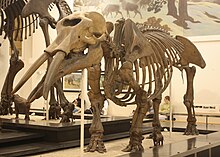| Gomphotherium Temporal range:
| |
|---|---|

| |
| Specimen of Gomphotherium productum at the American Museum of Natural History | |
| Scientific classification | |
| Domain: | Eukaryota |
| Kingdom: | Animalia |
| Phylum: | Chordata |
| Class: | Mammalia |
| Order: | Proboscidea |
| Family: | †Gomphotheriidae |
| Genus: | †Gomphotherium Burmeister, 1837 |
| Type species | |
| Gomphotherium angustidens (Cuvier, 1817)
| |
| Species | |
|
See text | |
| Synonyms | |
Gomphotherium (/ˌɡɒmfəˈθɪəriəm/; "nail beast" for its double set of straight tusks) is an extinct genus of gomphothere proboscidean from the Neogene of Eurasia, Africa and North America.[1][2] It is the most diverse genus of gompothere, with over a dozen valid species. The genus is probably paraphyletic.[3][4]
- ^ Wang, Wei; Liao, Wei; Li, Dawei; Tian, Feng (1 July 2014). "Early Pleistocene large-mammal fauna associated with Gigantopithecus at Mohui Cave, Bubing Basin, South China". Quaternary International. 354: 122–130. Bibcode:2014QuInt.354..122W. doi:10.1016/j.quaint.2014.06.036. ISSN 1040-6182.
- ^ Palmer, T. S.; Merriam, C. H. (1904). Index generum mammalium: a list of the genera and families of mammals. Government Printing Office, Washington.
- ^ Wu, Yan; Deng, Tao; Hu, Yaowu; Ma, Jiao; Zhou, Xinying; Mao, Limi; Zhang, Hanwen; Ye, Jie; Wang, Shi-Qi (16 May 2018). "A grazing Gomphotherium in Middle Miocene Central Asia, 10 million years prior to the origin of the Elephantidae". Scientific Reports. 8 (1): 7640. Bibcode:2018NatSR...8.7640W. doi:10.1038/s41598-018-25909-4. ISSN 2045-2322. PMC 5956065. PMID 29769581.
- ^ Baleka, Sina; Varela, Luciano; Tambusso, P. Sebastián; Paijmans, Johanna L.A.; Mothé, Dimila; Stafford, Thomas W.; Fariña, Richard A.; Hofreiter, Michael (January 2022). "Revisiting proboscidean phylogeny and evolution through total evidence and palaeogenetic analyses including Notiomastodon ancient DNA". iScience. 25 (1): 103559. Bibcode:2022iSci...25j3559B. doi:10.1016/j.isci.2021.103559. PMC 8693454. PMID 34988402.